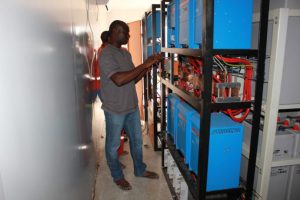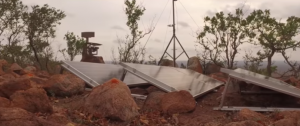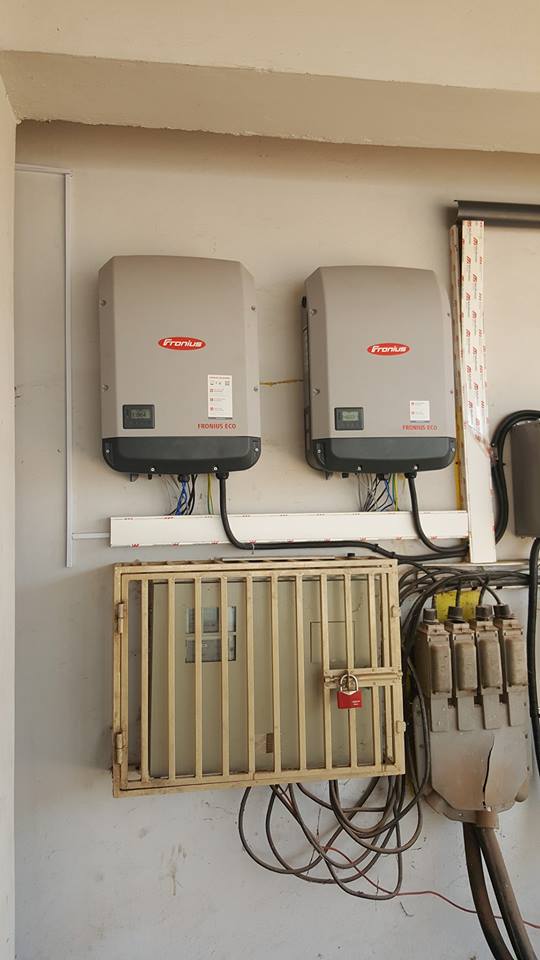Total Ghana Limited on Friday, commissioned its first solar-powered service station in the country with a 35-kilowatt capacity, at the Tema main harbour.This expected to save the company at $1000 per moth in electricity bills
The solar-powered station has a total of 225m2 solar panels comprising of 165m2 on the station’s shop and restaurant building, and 60 m2 on the pump island canopy.
Mr Eric Fanchini, Managing Director, said the energy architecture comprises of the solar panels, inverters, batteries, genset and the grid.
Mr Fanchini stated that it was his outfit’s goal to solarize at least 50 per cent of their network of 250 service stations within five years.
He indicated that the solar installation was in accordance with the company’s ambition of being the ‘responsible energy major’ as solar was now part of the modernization plan of Total Petroleum Ghana.
Dr Mohammed Amin Adam, Deputy Minister of Energy, commended management of Total for taking advantage of the abundant renewable energy opportunities in the country.
Dr Adam announced that the Ministry of Energy had commenced the implementation of the scaling-up Renewable Energy Program (SREP) with the objective of delivering over 55 mini-grids, 38,000 stanalone solar home systems and 15,000 net-metered solar-with-storage systems for homes and small-medium enterprise across the country.
Dr Adam added that the Ministry was accelerating the process of promoting the use of solar in public buildings and facilities to reduce their reliance on the national grid as well as improve the financial health of the utility companies.
“We are currently procuring 65k Wp solar to meet about 35-40 per cent of the Ministry’s total load and this would be extended to cover the other state institutions”.
Mr Kojo Jackson, Director, Human Resource and Administration, National Petroleum Authority (NPA) congratulated Total for being the first petroleum company to commission a solar service station in Ghana and urged them to maintain the high standards in their operations.
Mr Jackson expressed concern about the illegal fuel activities undertaken by some unscrupulous persons noting that the NPA was collaborating with the security agencies to deal ruthlessly with any person found culpable in the act.
He added that any licensed petroleum service provider found to be engaging in any illegality would have its operating license suspended or permanently revoked.
–
Source: GNA


 If you are a state broadcaster, Fiji is a difficult region.It takes Victron Energy to power Digital TV in Fiji
If you are a state broadcaster, Fiji is a difficult region.It takes Victron Energy to power Digital TV in Fiji



 Education and
Education and  The government recognizes the importance of education and seeks to offer an equal opportunity to all Botswanan children -regardless of whether they grow up in the city – or remotely. No electricity means no computers – and without learning computer skills a child becomes part of a lost generation …unable to reach his/her full potential. For that reason the Government have signed off this initiative which represents one of their biggest, newest investments.
The government recognizes the importance of education and seeks to offer an equal opportunity to all Botswanan children -regardless of whether they grow up in the city – or remotely. No electricity means no computers – and without learning computer skills a child becomes part of a lost generation …unable to reach his/her full potential. For that reason the Government have signed off this initiative which represents one of their biggest, newest investments. A long way from the cities, sophistication of these electronic installations is an unfamiliar sight – but no short-cuts have been made in guaranteeing the future of electricity provision, with state of the art power plants which may comprise of up to 12 Inverters 48V
A long way from the cities, sophistication of these electronic installations is an unfamiliar sight – but no short-cuts have been made in guaranteeing the future of electricity provision, with state of the art power plants which may comprise of up to 12 Inverters 48V  Now the very latest technology is available to these children as an educational tool. No matter that their school is far out of town, increasingly rural children can enjoy the same advantages as children in the cities.By taking a long-term view the power needs of
Now the very latest technology is available to these children as an educational tool. No matter that their school is far out of town, increasingly rural children can enjoy the same advantages as children in the cities.By taking a long-term view the power needs of Think about this: In the UK the average annual bill for electricity today is £600. The average annual electricity price-rise is 8%. In 25 years time (the lifetime of a solar panel) the average annual bill for electricity will be £4,100. The economic argument for generating your own electricity from Solar Power has been won – going off-grid is the way,it’s cheaper.In many ways – the Botswanan Government, and Botswanan schoolchildren are showing us the way ahead.
Think about this: In the UK the average annual bill for electricity today is £600. The average annual electricity price-rise is 8%. In 25 years time (the lifetime of a solar panel) the average annual bill for electricity will be £4,100. The economic argument for generating your own electricity from Solar Power has been won – going off-grid is the way,it’s cheaper.In many ways – the Botswanan Government, and Botswanan schoolchildren are showing us the way ahead.
 Financed mainly by charitable donations the surveillance installations are highly mobile, frequently moved, and can be packed for deployment by truck – or even slung under a helicopter and flown-in to new surveillance sites.
Financed mainly by charitable donations the surveillance installations are highly mobile, frequently moved, and can be packed for deployment by truck – or even slung under a helicopter and flown-in to new surveillance sites.
 As the solar inverter industry is becoming more commodified every year, inverter spec sheets are starting to look a lot more similar. Many inverter capabilities are driven by the same market requests and NEC code regulations, making features and pricing very similar across all inverter brands in the market. Therefore, a buyer could think that the only thing to look at is the price tag. However, it’s crucial to actually look past the spec sheet and the initial purchase price. When picking an inverter, you not only chose a piece of equipment, you are choosing a partner to work with for the next 20+ years. Thus, you might want to look into more than just “the box” and its price.
As the solar inverter industry is becoming more commodified every year, inverter spec sheets are starting to look a lot more similar. Many inverter capabilities are driven by the same market requests and NEC code regulations, making features and pricing very similar across all inverter brands in the market. Therefore, a buyer could think that the only thing to look at is the price tag. However, it’s crucial to actually look past the spec sheet and the initial purchase price. When picking an inverter, you not only chose a piece of equipment, you are choosing a partner to work with for the next 20+ years. Thus, you might want to look into more than just “the box” and its price.










 GRADE refers to the quality of solar cell used in the solar panel, and are categorized as A, B, C, or D. “Grade A” cells are the highest quality, in that they are tested to ensure there are no micro-cracks in the solar cell, and all the cells are of the same type. The quality diminishes for grade B, which may have micro cracks and not all cells are of the same type (they sometimes mix and match). Grades C and D are much worse quality with larger cracks and chips, and the cell mismatch is even worse since typical solar cell will be exposed to sunlight throughout its lifetime. Sunlight contains harmful ultraviolet (UV) light that deteriorates all materials, including solar cells. The tiny flaws in the material become worse after prolonged exposure to sunlight, and its power output reduces over time.As a grade A cell has the least flaws to start with, its deterioration will be the slowest.
GRADE refers to the quality of solar cell used in the solar panel, and are categorized as A, B, C, or D. “Grade A” cells are the highest quality, in that they are tested to ensure there are no micro-cracks in the solar cell, and all the cells are of the same type. The quality diminishes for grade B, which may have micro cracks and not all cells are of the same type (they sometimes mix and match). Grades C and D are much worse quality with larger cracks and chips, and the cell mismatch is even worse since typical solar cell will be exposed to sunlight throughout its lifetime. Sunlight contains harmful ultraviolet (UV) light that deteriorates all materials, including solar cells. The tiny flaws in the material become worse after prolonged exposure to sunlight, and its power output reduces over time.As a grade A cell has the least flaws to start with, its deterioration will be the slowest.